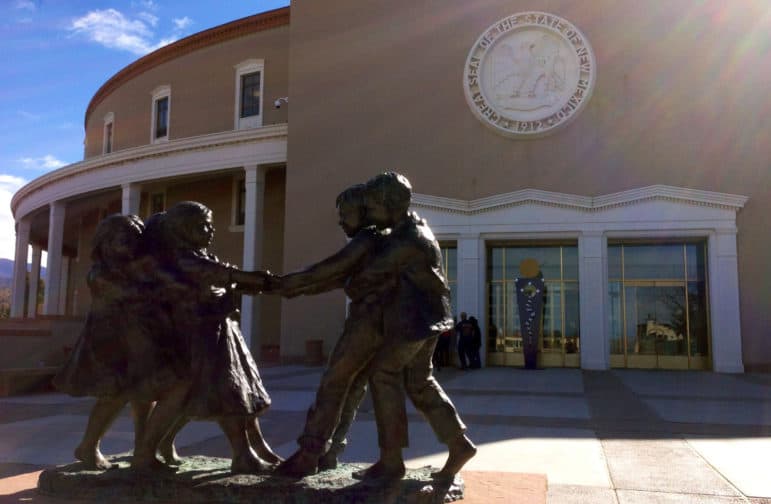
Heath Haussamen / NMPolitics.net
A statue outside the Roundhouse in Santa Fe.
Note: This commentary is in response to the article, “Systemic racism claimed in proposal’s defeat,” published by the Albuquerque Journal on Feb. 20.
COMMENTARY: In New Mexico, 90 percent of Native American 4th graders are below reading proficiency levels. Only 61 percent of African American high schoolers graduate in four years. Hispanic/Latino households have a median annual income that is $15,000 less than white households.
These data are consistent with countless others that make clear that there is an epidemic of racial inequity in New Mexico.
What is less clear to many is that addressing these inequities would benefit the entire population of the state, not just communities of color. With nearly 80 percent of New Mexico’s 0-19-year olds being non-white, not addressing these vast inequities will lead to continued economic challenges for the entire state. Yet, New Mexico’s leaders have failed to act and turned a blind eye to this large and growing crisis.
These outcomes are a direct result of institutional racism, or the differential access to goods, services and opportunities of society due to the existence of programs, policies and practices that intentionally or unintentionally place certain racial and ethnic groups at a disadvantage in relation to other groups. Institutional racism results in racial and social inequities with respect to health, education, criminal justice, the environment, employment, housing, the economy and other key indicators of wellbeing in New Mexico.
To be clear, institutional racism is not about the individual acts of racial prejudice, discrimination and bias (whether conscious or unconscious). Thus, the lack of movement in policy to address these outcomes is not about any one individual (or group of individuals) being racist. These are system-level failures that require system-level reform.
And the proposal to invest from New Mexico’s Land Grant Permanent Fund into early childhood education and services will help to level the playing field, especially for New Mexico’s children of color.
But this bold policy solution has become so politicized that just speaking its name can immediately put friends at odds. In 2003, a constitutional amendment was proposed by the Legislature, passed that same session, and New Mexico’s voters decided to increase the distribution from the Land Grant Permanent Fund for public and higher education. Notably, that same year the Legislature pushed through one of the biggest tax cuts in the history of the state when it slashed personal income tax by half for the wealthiest New Mexicans.
In 2016, that distribution from the Land Grant Permanent Fund phased out, as scheduled, and the distribution is now near the pre-2003 level of 4.7 percent.
Decades of research shows that investments in high-quality early childhood education and services can narrow the readiness/achievement gap, boost children’s lifetime earnings potential, and decrease delinquency and crime. The earnings from increased enrollment in early childhood education would provide short- and long-term benefits that far outweigh their costs.
Recent analysis done by Nobel Prize-winning economics professor James Heckman now indicates that the return on investment into such services is 13 percent. Compare this to the Land Grant’s current Wall Street return of 6 percent. The Land Grant Permanent Fund makes its money from oil and gas royalties and their stock market dividends and grows at a rate of nearly 11 percent each year. It is currently estimated at $17.2 billion.
For the past many legislative sessions, the N.M. State Senate has failed to give New Mexico voters the choice of increasing the distribution again. Given the overwhelming evidence of the high return on investment from early childhood expansion, the lack of action simply perpetuates more inequalities and injustice.
In closing, it is important to note that the Legislature would not actually be voting to utilize the Land Grant Permanent Fund for this purpose, but only to allow the electorate to make that decision. By withholding this critically important opportunity from the voting public we are not only perpetuating institutional racism but also limiting all New Mexicans from practicing democracy.
Serge Martínez, J.D., is the director of the UNM School of Law’s Economic Justice Clinic. (Note: The views expressed are those of the individual author and not the UNM School of Law.) Gabriel Sánchez, PhD, is a political scientist and expert in racial and ethnic politics. Agree with their opinion? Disagree? NMPolitics.net welcomes your views. Learn about submitting your own commentary here.